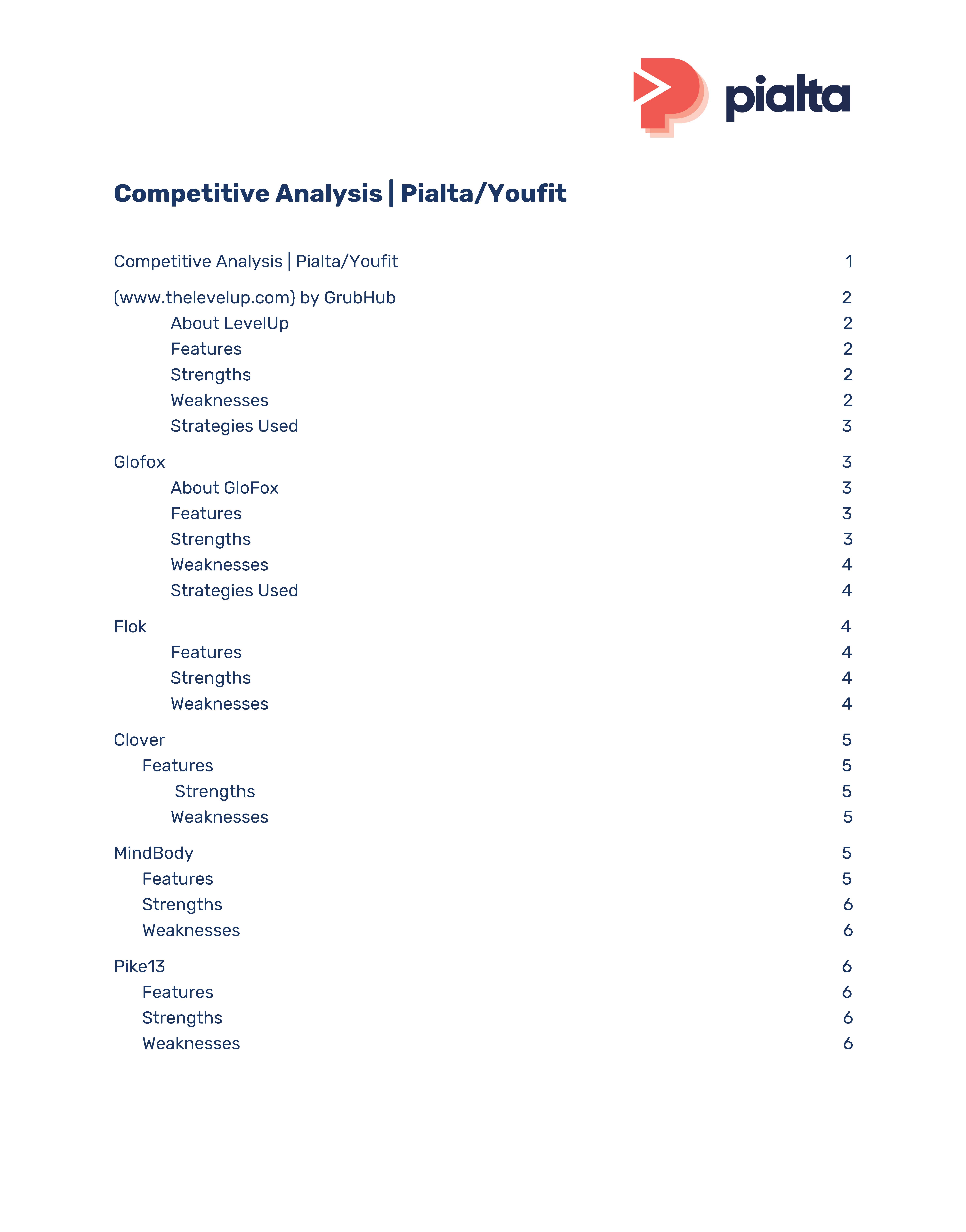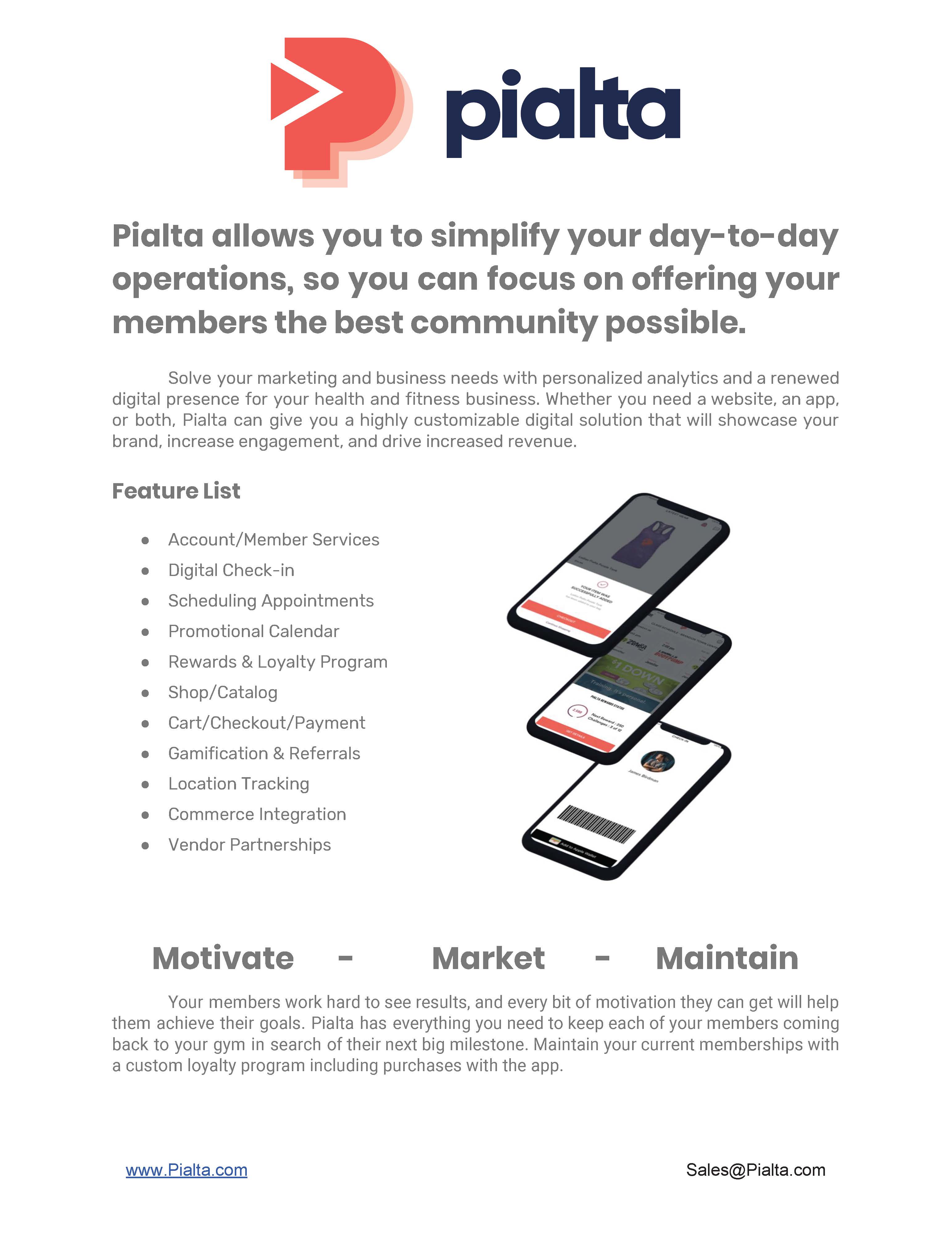Project Description
In the fall of 2019, PeakActivity decided to move forward with a new product serving the determined need to create a mobile platform for health and fitness clubs. Having worked with a fitness company in the past creating an app, the company wanted to take the platform to others. It would offer gyms an app that allows for class sign-ups, member management, payment, and merchandise purchasing, The app will come with a desktop portal aimed at giving gyms data about their members and tools to manage their business such as employee management and billing tools. As a writer with the company, they tasked me with putting together business research documents and a marketing pitch for the new product.
Audience
The audience of this work had two parts. The business documents were to be read by the upper management of the company and the developers. The documents I came up with would become the first features list by which the developers would assemble the product. The marketing documents and website content that I created would have a very narrow audience of gym owners and managers looking for an all in one studio management tool. To better understand this audience, I spoke to the project lead for the fitness company that PeakActivity already worked with. Along with my partner, we gathered notes from the meeting and determined that the most important thing to focus on when marketing to this audience is the inclusion of data. Fitness studio management wants to know the data that will help them keep their members. This was something that we focused on when writing marketing materials moving forward.
Project Overview
- Client: Pialta
- Role: UX Designer
- Duration: July 2019 - Present
Tools
- UX Methodologies
- Content Writing
- Competitive Analysis
- Persona
- Market Research
- User Interviews
- Professional communication processes, procedures and practices
- Visual communication theories and practices
- Technological and media production literacies
- Rob Petrisino: Partner
Competencies
Credits
Constraints and Goals
The rhetorical goals that I had for this project were to create documents that would become a development roadmap for the company while creating this platform. By completing a competitive analysis I could determine the need for the product in the health and fitness world and also the features that we would need to provide to remain competitive. My goal was to create content that reflected the research that I had done to create an end product that would be marketable.
Process
Step One: Audit and Analysis
In step one, I conducted my research to find out the current state of content in and around health and fitness club apps. I created an extensive competitive analysis to see what strategies other companies were using and what their strengths and weaknesses were. I also spoke to a health and fitness app used to determine what his goals were in getting an app and how it would best help him.
Step Two: Strategy
In step two I analyzed my research to decide how it could help us reach our audience. I created a business canvas comprising target audience analysis and messaging that we could use to best reach them. This included a journey map of the problems they face and the solutions that we could provide to solve those problems. I included our unique market add for each problem and the strategies we can use to reach users at that point. The document also listed existing alternatives from the competitive analysis. I also created a document containing all. I created short blubs that called out the best features that the product will offer and how it can help the end-user.
Step 3: Plan
In step three I decided on the content that would work best, the outlets to used to reach prospective users. I added this information to the business canvas.
Step 4: Create
In step four I began creating content for the Pialta. I began with short social media blurbs that would call out the problems I had listed and tell the user how we would solve them. From that messaging, I began work on the website content. I used the pain points to determine that health studios want to market themselves to potential customers, motivate their current customers, and maintain their business. These three goals became the main headers on the website and also headings on our one-page flyer. My coworker created a web design and branding materials for the product.
Step 5: Maintain
In step 5, I made a plan to continue to develop content as the product is being built. The current list of goals is to create a sales pitch, and a user guides along with developer documentation. As we create the content, I hope to test our messaging with users and adapt as we continue to grow the product. Periodically, I add more research to my competitive analysis to keep up with the growing market. I will take this information into account as I continue to build content.
While this project is still in the early stages, below is the sales sheet that I have created and the mock-up website with the I have written content included.
While this project is still in the early stages, below is the sales sheet that I have created and the mock-up website with the I have written content included:



Reflection on this Project
As a new member of a growing company, I am happy to learn from my coworkers as I grow my skills. This project was interesting in the fact that it was taking place at nearly the same time as I was taking a content strategy course where I worked on a content strategy for the Clemson English Department. In completing the readings for that class, I could take what I was learning back to my company. My boss has a marketing background and was assigning me tasks similar to the content strategy that I was learning, but they didn’t overlap. For example, at the beginning of the project, he had me begin work on a business canvas. While I had never heard of the business canvas before, I discovered quickly that it operated in similar ways to a journey map in the sense that it required creating scenarios about users and solving for how to reach them throughout that scenario. The setup was similar, but the journey map creates a more narrow focus while the business canvas was used to plan all marketing material. I have been happy to transfer my skills to this project, and I am looking forward to seeing how the product comes together.